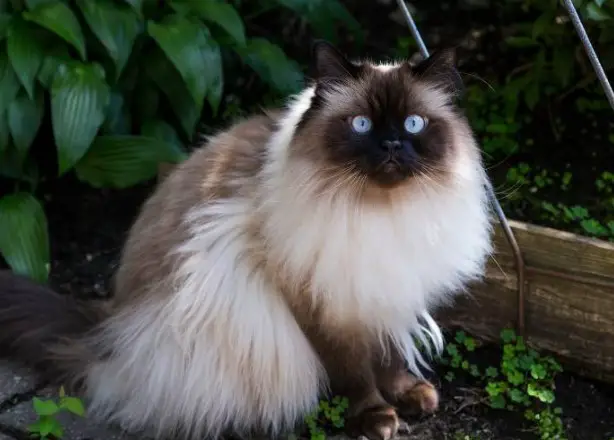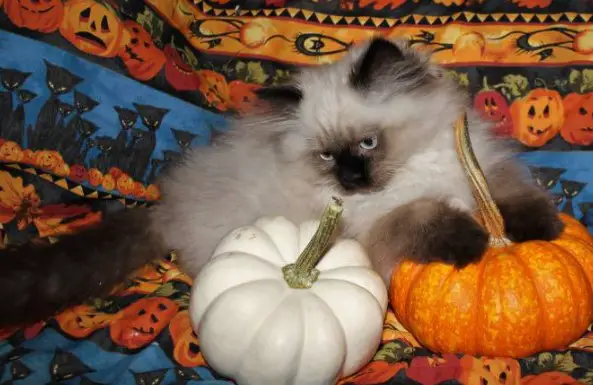The Himalayan cat carries the roots of the cute handsome Persian and the Siamese fidget. The Himalayans borrowed a luxurious fur coat from the first breed, and the coat color and eye color from the second. Whether such a pet is suitable for you, you should find out before you go to the nursery. What is the difference between these blue-eyed beauties with chic fur coats?
Description of the breed
The Himalayan cat carries the roots of the cute handsome Persian and the Siamese fidget. From the first breed, the Himalayans borrowed a luxurious fur coat, and from the second – the color of the coat and the color of the eyes. Whether such a pet is suitable for you, you should find out before you go to the nursery. What is the difference between these blue-eyed beauties with chic fur coats?
Description of the breed England and America are considered this homeland. In the 30s of the last century, breeders crossed black Persian and Siamese cats, resulting in black kittens with short hair. Breeders have spent almost 20 years preserving the colorpoint gene. In 1950, the first Persian cat with a Siamese color appeared in America. After another 7 years, the Himalayan cat breed was recorded, which was named because of this color – by analogy with the Himalayan rabbit. English breeders also did not abandon the attempt to get a Persian Siamese, and at the same time, they bred the same cat in 1955, calling it a long-haired exact colorpoint.
An adult Himalayan cat can weigh 4 to 6 kilograms.
How to choose a kitten
When choosing a kitten, be sure to read the requirements of the Himalayan Persian breed standard. Carefully study the photos on the Internet in order to clearly understand how your pet should look. Cats from unscheduled breeding can have serious genetic diseases.
Therefore, you should give preference only to registered nurseries, study reviews of breeders, visit the nursery in person. Animals in the nursery must be clean, well-fed, and well-groomed. Look at the parents of your future pet – they should be of the standard, be healthy, not thin.
Character
Persian color point has an affectionate, gentle and calm character. You are hardly such a pet swinging on the curtains, but in your arms, he will sit with pleasure. They have a sharp mind, they can adjust to your mood.
However, playful Siamese genes show themselves from time to time. In childhood, the Himalayan Persian is very active, friendly, and does not mind playing at all. Representatives of this breed are perfect for families with children, the Himalayans get along quite calmly with other animals in the house.
Features of care
Since the Himalayan cat has a long and thick coat, it needs regular, almost daily brushing. A cute face affects the work of the lacrimal glands, so these cats have profuse lacrimation, their eyes need to be cleaned every day, for this you need a cotton pad dipped in a special solution to clean the eyes. You can find such a tool in any pet store. In this breed, the sebaceous glands also work quite actively, in which they need regular bathing.
Fortunately, the Himalayan Persian loves water treatments, so you shouldn’t have any difficulties with bathing. Also, do not forget to regularly clean your pet’s ears, take him to consult a veterinarian in order to get the full range of necessary vaccinations. Every six months, deworming should be carried out and the cat should be treated for fleas.
Health
Like the Persian, the Himalayan cat is prone to polycystic kidney disease and diseases associated with the corresponding respiratory system – due to a flattened face. Skin, vision, and liver problems are also common. To avoid health problems, do not forget to show your pet to the vet and feed him properly. On average, representatives of this breed live for about 12 years.
Food
The Himalayan cat is a big lover of tasty food. To prevent your pet from becoming obese, the amount of food consumed should be monitored and controlled during the diet. Ready-made feeds allow you to control the amount of food and beneficial micro and macro elements that your pet receives. If you decide to give preference to natural products, in no case feed the cat with your lunch – the animal’s diet should not contain salt, spices, and sugar. 60% of the menu should be meat, preferably boiled and in no case fatty. You can also feed the animal with fermented milk products, eggs, cereals, vegetables. Fish should not be given – it provokes kidney disease in cats.
Mating
The Himalayan cat is ready to mate after one year of age, although the first heat can occur as early as 5-6 months. When planning a mating, pay special attention to the color of the future kittens – it is, of course, unlikely to determine the color of the kittens for sure, of course, but, for example, if you do not want babies with red marks, you should not knit a cat with a cat of this color.
